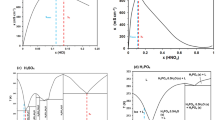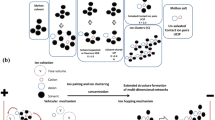Abstract
We adopt a verified transition-state theory as well as the boundary perturbation method to calculate the ionic conductivities for a class of bismuth oxysulfates like \(\hbox {Bi}_9\hbox {SO}_{16.5}\) as well as \(\hbox {Bi}_6\hbox {S}_2\hbox {O}_{15}\). Our numerical results compared with previous experimental data of ionic conductivities of \(\hbox {Bi}_9\hbox {SO}_{16.5}\) (Smirnov et al. in Solid State Ionics 156:79–84, 2003) show rather good fit. We then predict numerically the ionic conductivities for \(\hbox {Bi}_6\hbox {S}_2\hbox {O}_{15}\) by selecting a suitable activation energy.


Similar content being viewed by others
References
V.I. Smirnov, V.G. Ponomareva, YuM Yukhin, N.F. Uvarov, Fluorite-related phases in the \({\rm Bi}_2{\rm O}_3-{\rm SO}_3\) system. Solid State Ionics 156, 79 (2003)
M.G. Francesconi, A.L. Kirbyshire, C. Greaves, O. Richard, G. Van Tendeloo, Synthesis and structure of \({\rm Bi}_{14}{\rm O}_{20}({\rm SO}_4\)): A new Bismuth Oxide Sulfate. Chem. Mater. 10, 626 (1998)
Y. Zhou, G.R. Patzke, \({\rm Bi}_2{\rm O}_3\) or \({\rm Bi}_6{\rm S}_2{\rm O}_{15}\) nanowires? The role of templating inorganic additives in nanomaterials formation. Cryst. Eng. Commun. 14, 1161 (2012)
Y. Zhou, J.-D. Grunwaldt, F. Krumeich, Kb Zheng, Gr Chen, J. Stötzel, R. Frahm, G.R. Patzke, Hydrothermal synthesis of \({\rm Bi}_6{\rm S}_2{\rm O}_{15}\) nanowires: structural, in situ EXAFS, and humidity-sensing studies. Small 6, 1173 (2010)
D. Brouillette, G. Perron, J.E. Desnoyers, Effect of viscosity and volume on the specific conductivity of lithium salts in solvent mixtures. Electrochim. Acta 44, 4721 (1999)
A. Chagnes, B. Carré, P. Willmann, D. Lemordant, Ion transport theory of nonaqueous electrolytes. \({\rm LiClO}_4\) in g-butyrolactone: the quasi lattice approach. Electrochim. Acta 46, 1783 (2001)
H. Eyring, M.S. Jhon, Significant liquid structures (Wiley, New York, 1969)
S. Glasstone, K.J. Laidler, H. Eyring, The theory of rate processes (McGraw-Hill, New York, 1941)
Yg Oh, M.S. Jhon, H. Eyring, Significant structure theory applied to liquid helium-3. Proc. Natl. Acad. Sci. (USA) 74, 4739 (1977)
W.K.-H. Chu, Stokes slip flow between corrugated walls. Zeitsch. Angew. Math. Phys. 47, 591 (1996)
R.K.-H. Chu, Effect of activation volume on the defect-induced anomalous electronic transport in \({\rm Rb}_{0.8}{\rm Fe}_2{\rm Se}_2\). J. Math. Chem. 52, 1831 (2014)
C.G. Jesudason, An energy interconversion principle applied in reaction dynamics for the determination of equilibrium standard states. J. Math. Chem. 39, 201 (2006)
Author information
Authors and Affiliations
Corresponding author
Rights and permissions
About this article
Cite this article
Kwang-Hua, C.R. Conductivities of ionic fluids in bismuth oxysulfates. J Math Chem 53, 1105–1112 (2015). https://doi.org/10.1007/s10910-014-0441-y
Received:
Accepted:
Published:
Issue Date:
DOI: https://doi.org/10.1007/s10910-014-0441-y




